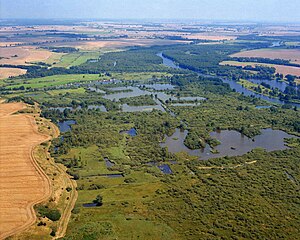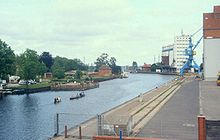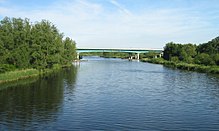Peene Valley
The Peene Valley is a natural spatial unit in Western Pomerania and in the northeast of Mecklenburg. These are the areas on the Peene in the Mecklenburg Lake District and in the Vorpommern-Greifswald district . The valley extends from the Kummerower See along the towns of Dargun , Demmin , Loitz , Jarmen , Gützkow and Anklam to the confluence with the Peene River . The Peene Valley is a largely untouched natural landscape with a high level of biodiversity . The major nature conservation project covers a core zone area of 20,000 hectares and a total area of 45,000 hectares. The Peene Valley is the largest contiguous fen area in Central Europe.
Origin and geomorphology
The Peene Valley comprises the areas that border the Peene in its course from the Kummerower See to its delta-like confluence with the Peene River. Despite its name, the Peene River is no longer part of the Peene, but an estuary of the Oder and at the same time an arm of the Baltic Sea . With regard to the natural area , the Peene Valley is a lowland area characterized primarily by moors , forests , wet meadows and grasslands . In particular, the extensive fens can be traced back to the formation of the Peene around 10,000 years ago as meltwater drainage from the receding glaciers in the Oderhaff and Baltic Sea area during the Vistula Ice Age. At this time the water flowed to the west, creating a meltwater channel in the earlier ground moraine deposits, which formed the river bed of the Peene. This runs from Kummerower See to Loitz first in a north-easterly direction and then in an easterly or east-south-east direction to the mouth.
The Peene is one of the few unobstructed and non- dam-regulated rivers in Germany and is therefore practically completely shaped in its current state by its natural formation and shape. One result of this history of origin, which influences the shape and ecology of the Peene Valley to this day, is the very low gradient of the river, which from the Kummerower See is around 24 centimeters to around 100 kilometers in length and results in a very low flow velocity and a low flow rate . Furthermore, the 500 to 700 meter wide flood bogs in the Peene Valley are characterized by comparatively high groundwater levels , which, like the water levels of the Peene, are heavily dependent on weather influences such as wind direction and rainfall due to the connection to the Baltic Sea . Since the Baltic Sea acts as a heat store and buffer from a climatological point of view, the weather in the Peene Valley, as in the rest of the coastal areas, is characterized by milder summers and warmer winters compared to the inland part of Mecklenburg-Western Pomerania. The proximity of the Peene to the Oder and its lagoon has an impact on the biodiversity of your fish population due to the access of migratory fish.
fauna and Flora
In terms of its natural features, the Peene Valley is representative of a number of typical biotopes in the north German lowlands. It is characterized by a rich flora and fauna and acts as a retreat for a number of threatened and rare animal and plant species. Among the domestic here animals, for example, include a number of amphibians , including various toads , frogs and toads , and reptiles such as lizards , forest lizards , grass snakes and vipers , as well as beavers , otters , sea and spotted eagle , grain and Harriers and kingfishers . Of the 156 bird species registered in the Peene Valley, around 80 percent of the species recorded in Mecklenburg-Western Pomerania, around 40 percent are on the state's red list of endangered species , including 26 species that are protected throughout Europe. The Peene Valley is thus one of the most important bird habitats in Germany.
The 37 fish species that live regularly or temporarily in the Peene include lead , roach , perch , pike , tench and catfish . The species asp , loach , river and brook lamprey , mud whip and salmon , which also occur , are under special protection throughout Europe. It is very likely that the Peene is the river system with the most species of fish in Mecklenburg-Western Pomerania. An insect , a total of 149 beetle species , of which 24 with Red List status, and 33 dragonfly species, 64 butterfly types, and 483 moth species, including five species of the family Burnet demonstrated in Peenetal. Among the butterflies found in the Peene Valley, three species are considered critically endangered and nine are critically endangered. As rare plants such as various types of grow here orchids and other orchids that Mehlprimel , the common butterwort and the pulsatilla vulgaris . Other typical plants are shrub birches , globeflowers and the lung gentian . About 25 percent of the 740 plant species identified here are on the red list.
Economic use
The districts of Mecklenburg Lake District and Vorpommern-Greifswald, in which the Peene Valley is located, are not very well developed industrially and are characterized by a correspondingly low population density , predominantly village-like settlement and, compared to the national average and other parts of Mecklenburg-Vorpommern, high unemployment among the population . The demographic development is characterized by emigration and declining birth rate and a thereby caused in part obsolescence since 1990th The economic focus of the region is tourism and agriculture . For the use of the Peene and the adjacent areas of the Peene Valley, development is therefore primarily aimed at within the framework of so-called soft tourism . In the course of the Peene, which is also known as the “Amazon of the North” in its delta behind Anklam, there are several canoe stations and resting places for water hikers . There are marinas for recreational shipping, for example, in Loitz and Stolpe (Peene) . River cruises , on the other hand, play only a subordinate role in the tourist use of the Peene.
As a waterway for the industrial transport of goods, the Peene is only of limited regional importance. From its mouth to Demmin it is classified as a Category IV inland waterway , the further navigable part from Demmin to Malchin is classified as Category III. There are no navigable connections inland to economically relevant inland waterways. In the 1950s and 1960s there were plans to integrate the Peene into a waterway as part of a project known as the Recknitz-Trebel-Peene Canal , which would connect the Rostock overseas port , which opened in 1960, to inland shipping in what was then the German Democratic Republic (GDR) should. However, there was no implementation. Inland ports along the Peene exist in Malchin , Demmin , Loitz, Jarmen and Anklam . Here are the ports in Demmin, Anklam and Jarmen for freight of meaning whose turnover in 2003, taken together, around 85,890 tonnes was and were lower than in previous years. Around half of this was achieved through fertilizer , other goods with significant handling volumes were building materials , grain and scrap . The seaport of the city of Wolgast , located about 20 kilometers north of the Peene estuary on the Peenestrom , which is important for both inland and maritime shipping , achieved a turnover that was around ten times higher than that.
Traffic and industrial structures
The Baltic A20 motorway , which was completed in 2005 and runs from the Uckermark to Lübeck, runs through the Peene Valley near Jarmen and Gützkow. It crosses it the Peene and adjacent areas on the 1,110 meter long Peene Valley Bridge , which was built from 1998 to 2001. The bridge is characterized by a special cross-section without hard shoulder and with a reduced median width , a noise-reducing road surface , sealed protective walls against the entry of splash water and a limitation of the driving speed to 100 kilometers per hour. In addition, an area of 186 hectares in the Peene Valley was renatured to provide ecological compensation for the bridge construction . Despite these measures, the construction of the motorway through the ecologically sensitive Peene Valley was highly controversial and was accompanied by sometimes intense protests, including a hut village built by opponents of the motorway near the town of Breechen . The raised bog beetle ( Carabus menetriesi menetriesi ) became a symbol of the ultimately unsuccessful resistance, but also to some extent for the rejection of nature and landscape protection demands that were exaggerated from the point of view of the motorway proponents .
Two industrial buildings that are run by the Peenetal and are due to the possible impact of the construction on nature and landscape as controversial, are those of the Hamburg company Concord Power planned NORDAL pipeline and by the company Wingas targeted OPAL pipeline to transport of natural gas . Both pipelines are intended to transport the natural gas that would be imported from Russia with the Baltic Sea pipeline , which will probably go into operation in 2011 and land at Lubmin near Greifswald , to Bernau near Berlin in Brandenburg and Olbernhau in Saxony . The approved route of both gas lines would partially run parallel to the A20 and cross the Peene Valley. Construction of the OPAL pipeline began in October 2009, and all the necessary permits have also been obtained for the NORDAL pipeline.
natural reserve
In the Peene Valley, 9,600 hectares are designated as nature reserves:
- Anklamer Stadtbruch nature reserve
- Nature reserve Peenetal from Salem to Jarmen (with the previous NSG Devener Holz and Neukalener Moorwiesen )
- Nature reserve Peenewiesen near Gützkow
- Nature reserve Peenetal west of the Gützkower ferry dam
- Schwingetal and Peenewiesen nature reserve near Trantow
- Lower Peenetal nature reserve (Peenetalmoor)
It also contains the protected landscape areas of Mecklenburg Switzerland / Kummerower See , Trebeltal and Unteres Peene Valley . In addition, the region under the name “Peenetal from Kummerower See to Schadefähre” is a bird sanctuary according to EC Directive 79/409 / EEC. The Peene Valley was a major nature conservation project of the Federal Agency for Nature Conservation (BfN) under the name "Peenetal / Peene-Haff-Moor" with a financial volume of 31.1 million euros for the funding period from 1992 to 2008, around 73 percent of which was provided by the federal government . The state of Mecklenburg-Western Pomerania contributed around 19 percent of the financing, the “Peenetal-Landschaft” association responsible for implementing the project, based in Anklam, contributed around eight percent. Members of the association are the cities of Demmin, Loitz, Jarmen, Gützkow and Anklam, the two districts affected and the “Nature Conservation in the Peene Valley” association, through which voluntary nature conservation is involved in the project.
Since the Jasmund National Park , the Müritz National Park and the Vorpommersche Boddenlandschaft National Park are already three of the 14 German national parks in the state of Mecklenburg-Vorpommern, the state government has the establishment and maintenance of a national park "Peenetal" under state sponsorship in connection with the BfN Funding rejected several times. Proposals for the realization of a national park in the form of a foundation based on private funds were also rated by the responsible authorities and associations as not feasible for legal and financial reasons. Instead, the Peenetal River Landscape Nature Park was founded in July 2011 with an area of around 33,400 hectares. The seat of the nature park is in Stolpe .
literature
- Mike Stegemann, Frank Hennicke: Establishment and safeguarding of parts of nature and landscape worthy of protection with national representative significance. Project: Peenetal / Peene-Haff-Moor, Mecklenburg-Western Pomerania. In: Nature and Landscape. Issue 7/8, 1991. Federal Agency for Nature Conservation, pp. 287–294, ISSN 0028-0615 .
- Barbara Havenstein, Frank Hennicke, Mike Stegemann, Jens Kulbe (authors), Zweckverband “Peenetal-Landschaft” Anklam (editor): Nature and hiking guide Peenetal. Hoffmann-Druck GmbH, Wolgast 1998.
- Erich Hoyer: Naturalist guide to the island of Usedom. With lagoon coast, Ueckermünder Heide and lower Peene valley. Verlag Erich Hoyer, Galenbeck 2001, ISBN 3-92-919213-6 .
- Frieder Jelen : A national park in the Peene Valley. Is a vision becoming a reality? In: National Park. Wilderness - people - landscape. 1/2006. Association of Friends of the First German National Park Bavarian Forest eV, p. 4–7.
Web links
- Large-scale nature conservation project Peenetal landscape
- BfN: Peenetal information from the Federal Agency for Nature Conservation
- Friends 'Association "Nature Conservation in the Peene Valley" Official website of the Friends' Association
- Official website of the Peenetal River Landscape Nature Park





